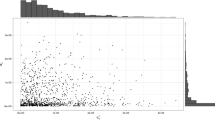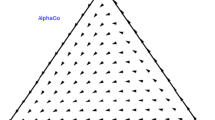Abstract
We consider simple Markovian games, in which several states succeed each other over time, following an exogenous discrete-time Markov chain. In each state, a different simple static game is played by the same set of players. We investigate the approximation of the Shapley–Shubik power index in simple Markovian games (SSM). We prove that an exponential number of queries on coalition values is necessary for any deterministic algorithm even to approximate SSM with polynomial accuracy. Motivated by this, we propose and study three randomized approaches to compute a confidence interval for SSM. They rest upon two different assumptions, static and dynamic, about the process through which the estimator agent learns the coalition values. Such approaches can also be utilized to compute confidence intervals for the Shapley value in any Markovian game. The proposed methods require a number of queries, which is polynomial in the number of players in order to achieve a polynomial accuracy.
Similar content being viewed by others
References
Agresti A, Coull B (1998) Approximate is better than “exact” for interval estimation of binomial proportions. Am Stat 119–126
Athreya KB, Fuh CD (1992) Bootstrapping Markov chains: countable case. J Stat Plan Inference 33:311–331
Aumann RJ (1994) Economic applications of the Shapley value. In: Mertens SSJ-F (ed) Game-theoretic methods in general equilibrium analysis. Kluwer Academic, Dordrecht, pp 121–133
Aumann RJ, Hart S (1994) Handbook of game theory with economic applications, vol 2. Elsevier, Amsterdam
Avrachenkov K, Elias J, Martignon F, Neglia G, Petrosyan L (2011) A Nash bargaining solution for cooperative network formation games. In: NETWORKING, vol 2011, pp 307–318
Avrachenkov K, Cottatellucci L, Maggi L (2012) Cooperative Markov decision processes: time consistency, greedy players satisfaction, and cooperation maintenance. Int J Game Theory. doi:10.1007/s00182-012-0343-9
Avrachenkov K, Cottatellucci L, Maggi L (2012) Dynamic rate allocation in Markovian quasi-static multiple access channels. Tech Rep RR-12-269, EURECOM
Bachrach Y, Markakis E, Resnick E, Procaccia A, Rosenschein J, Saberi A (2010) Approximating power indices: theoretical and empirical analysis. Auton Agents Multi-Agent Syst 20(2):105–122
Bachrach Y, Meir R, Feldman M, Tennenholtz M (2012) Solving cooperative reliability games. arXiv:1202.3700
Banzhaf JF III (1964) Weighted voting doesn’t work: a mathematical analysis. Rutgers Law Rev 19:317–343
Bilbao J, Fernandez J, Losada AJ, Lopez J (2000) Generating functions for computing power indices efficiently. Top 8(2):191–213
Chalkiadakis G, Markakis E, Boutilier C (2007) Coalition formation under uncertainty: bargaining equilibria and the Bayesian core stability concept. In: Proceedings of the 6th international joint conference on autonomous agents and multiagent systems. ACM, New York, p 64
Chernoff H (1952) A measure of asymptotic efficiency for tests of a hypothesis based on the sum of observations. Ann Math Stat 23(4):493–507
Clopper CJ, Pearson ES (1934) The use of confidence or fiducial limits illustrated in the case of the binomial. Biometrika 26(4):404–413
Filar J, Petrosjan LA (2000) Dynamic cooperative games. Int Game Theory Rev 2(1):47–65
Hoeffding W (1963) Probability inequalities for sums of bounded random variables. J Am Stat Assoc 58:13–30
Javadi F, Kibria MR, Jamalipour A (2008) Bilateral Shapley value based cooperative gateway selection in congested wireless mesh networks. In: IEEE GLOBECOM 2008. IEEE, New York, pp 1–5
Klinz B, Woeginger GJ (2005) Faster algorithms for computing power indices in weighted voting games. Math Soc Sci 49(1):111–116
Kranich L, Perea A, Peters H (2005) Core concepts for dynamic TU games. Int Game Theory Rev 7(1):43–61
Ma RTB, Chiu D, Lui J, Misra V, Rubenstein D (2007) Internet economics: the use of Shapley value for ISP settlement. In: Proceedings of CoNEXT 2007. Columbia University, New York
Mann I, Shapley LS (1960) Values of large games, IV. RAND Corporation, Memoradum RM-2651
Matsui T, Matsui Y (2000) A survey of algorithms for calculating power indices of weighted majority games. J Oper Res Soc Jpn 43:71–86
Matsui Y, Matsui T (2001) Np-completeness for calculating power indices of weighted majority games. Theor Comput Sci 263(1):305–310
Meir R, Tennenholtz M, Bachrach Y, Key P (2012) Congestion games with agent failures. In: Twenty-sixth AAAI conference on artificial intelligence
Penn M, Polukarov M, Tennenholtz M (2005) Congestion games with failures. In: Proceedings of the 6th ACM conference on electronic commerce. ACM, New York, pp 259–268
Penn M, Polukarov M, Tennenholtz M (2009) Congestion games with load-dependent failures: identical resources. Games Econ Behav 67(1):156–173
Petrosjan LA (2006) Cooperative stochastic games. In: Advances in dynamic games, pp 139–145
Prasad K, Kelly JS (1990) Np-completeness of some problems concerning voting games. Int J Game Theory 19(1):1–9
Predtetchinski A (2007) The strong sequential core for stationary cooperative games. Games Econ Behav 61(1):50–66
Shapley LS (1953) A value for n-person games. Contrib Theory Games 2:31–40
Shapley LS, Shubik M (1954) A method for evaluating the distribution of power in a committee system. Am Polit Sci Rev 48(3):787–792
Stanojevic R, Laoutaris N, Rodriguez P (2010) On economic heavy hitters: Shapley value analysis of 95th-percentile pricing. In: Proceedings of the 10th annual conference on Internet measurement. ACM, New York, pp 75–80
Tannenbaum P (1997) Power in weighted voting systems. Math J 7(1):58–63
Taylor A, Pacelli A (2008) Mathematics and politics: strategy, voting, power, and proof. Springer, Berlin
Wald A, Wolfowitz J (1939) Confidence limits for continuous distribution functions. Ann Math Stat 10:105–118. doi:10.1214/aoms/1177732209
Wilson EB (1927) Probable inference, the law of succession, and statistical inference. J Am Stat Assoc 22:209–212
Acknowledgements
The work of K. Avrachenkov and L. Maggi has been partially supported by “Agence Nationale de la Recherche,” with reference ANR-09-VERS-001, and by the European Commission within the framework of the CONGAS project FP7-ICT-2011-8-317672, see www.congas-project.eu. The work of L. Cottatellucci has been partially supported by “Agence Nationale de la Recherche,” with reference ANR-09-VERS-001, and by the European research project SAPHYRE, which is partly funded by the European Union under its FP7 ICT Objective 1.1—The Network of the Future. The authors would like to thank the reviewers for helpful remarks and Professor R. Lucchetti for drawing their attention to the reference [11].
Author information
Authors and Affiliations
Corresponding author
Additional information
Most of the work has been carried out while the third author was Ph.D. student at EURECOM.
Appendices
Appendix A: Proof of Theorem 2
Proof
We will prove that there exists a class \(\mathcal{F}\) of game instances for which any deterministic algorithm computing \(\mathrm {SS}_{j}^{(s)}\) with accuracy of at least 1/(2P) must utilize \(\varOmega(2^{P}/\sqrt{P})\) queries. Similarly to [8], let us construct \(\mathcal{F}\) when P is odd. Let \(\varLambda\subseteq\mathcal{P}\backslash\{j\}\). There exists a set D o of \(\binom{P-1}{[P-1]/2}/2\) coalitions of cardinality [P−1]/2 such that player j is critical only for D o . In particular, for |Λ|≤[P−1]/2, v (s)(Λ)=0; if |Λ|=[P−1]/2, then, if Λ∈D o , v (s)(Λ∪{j})=1, otherwise v (s)(Λ∪{j})=0. The values of the remaining coalitions are 1 if and only if they contain a winning coalition among the ones constructed so far. The Shapley value for player j is thus
Hence, for any deterministic algorithm ALG o employing a number of queries smaller than μ o (P), where
there always exists an instance belonging to \(\mathcal{F}\) for which ALG o would answer \(\mathrm {SS}_{j}^{(s)}=0\). By Stirling’s approximation, we can say that \(\mu_{o}(P) \in\varOmega(2^{P}/\sqrt{P})\). Let us now construct the class \(\mathcal{F}\) of instances when P is even and P>2. Let D e be a set of \(\binom{P-2}{[P-2]/2}\) coalitions of cardinality [P−2]/2, belonging to \(\mathcal{C}\backslash\{j\}\), such that player j is critical only for D e . Then
Similarly to before, for any deterministic algorithm ALG e using a number of queries smaller than
there always exists an instance belonging to \(\mathcal{F}\) for which ALG e would answer \(\mathrm {SS}_{j}^{(s)}=0\). By Stirling approximation, we can say that \(\mu_{e}(P)\in\varOmega(2^{P}/\sqrt{P})\). Hence, a number of samples \(\mu\in\varOmega(2^{P}/\sqrt{P})\) is needed to achieve an accuracy of at least 1/(2P). Hence, the thesis is proved. □
Appendix B: Proof of Corollary 1
Proof
Any deterministic algorithm employs a certain number of queries in each state s in order to compute \(\mathrm {SSM}_{j}(\varGamma_{s})=\sum_{i=1}^{|S|} \boldsymbol{\sigma}_{i}(s)\mathrm {SS}_{j}^{(s_{i})}\). Let I 0 be a game instance in which player j is a dummy player in all the single stage games {v (s)} s∈S , i.e., \(\mathrm {SS}_{j}^{(s)}=0\) for all s∈S. Let I 1 be a game instance such that \(\mathrm {SS}_{j}^{(s)}=0\) for all s except for s k , for which σ(s k )≠0, and such that the game \(\varPsi ^{(s_{k})}\) belongs to the class \(\mathcal{F}\) of instances described in the proof of Theorem 2. Therefore,
in the case that P is odd and
if P is even. Hence, any deterministic algorithm needs \(\varOmega (2^{P}/\sqrt{P})\) queries in state s k to achieve an accuracy better than σ k (s)/(2P). Set c=σ k (s)/2. Hence, the thesis is proved. □
Appendix C: Proof of Lemma 1
Proof
We will provide the proof for continuous random variables; the proof for the discrete case is totally similar. By induction, it is sufficient to prove that, if Pr(A 1∈[l 1;r 1])≥1−δ 1 and Pr(A 2∈[l 2;r 2])≥1−δ 2, then
Let f
A
be the probability density function of the r.v. A. Let  , i=1,2. Then
, i=1,2. Then

Hence, the thesis is proved. □
Appendix D: Proof of Theorem 4
Proof
Let us consider the following constrained minimization problem over the reals:
By using, e.g., the Lagrangian multiplier technique, it is easy to see that the optimum value for ω i is
and that the minimum value of the objective function is
The value ξ ∗ clearly represents a lower bound for the optimization problem over the integers in the case of simple games. Since we deal with the average criterion, let σ i (s)≡π i . Now we can find a lower bound for \(\sqrt{n} \widetilde{\varepsilon}(n,\delta)\) over n that does not depend on the number of queries n:

and the optimum value of x i in (14) is
For Theorem 3,
Hence, n i /n converges with probability 1 to the optimum value \(x^{*}_{i}\) and, by continuity, the thesis is proved. □
Appendix E: Proof of Lemma 2
Proof
In the case of simple Markovian games, the optimization problem (9) turns into
Let us consider the constrained minimization problem over the reals in (12). Since evidently ξ ∗, defined in (13), is not greater than the minimum value of the objective function in (15), then by straightforward inspection over the expressions (5) and (8) the thesis is proved. □
Rights and permissions
About this article
Cite this article
Avrachenkov, K., Cottatellucci, L. & Maggi, L. Confidence Intervals for the Shapley–Shubik Power Index in Markovian Games. Dyn Games Appl 4, 10–31 (2014). https://doi.org/10.1007/s13235-013-0079-6
Published:
Issue Date:
DOI: https://doi.org/10.1007/s13235-013-0079-6




